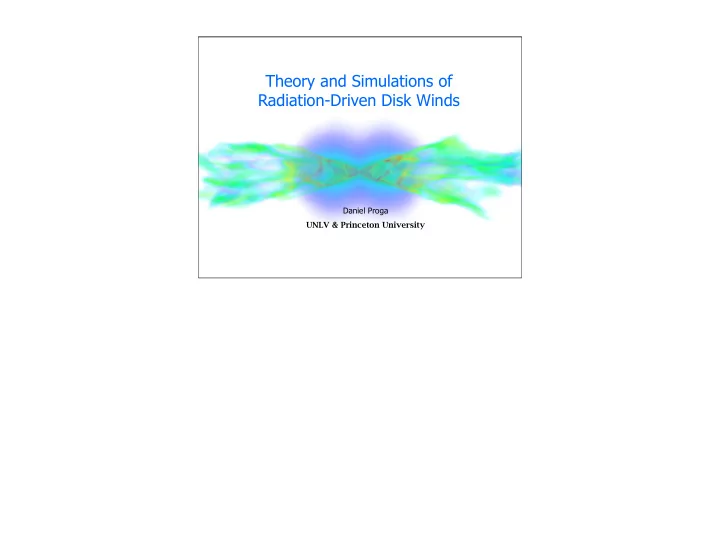

Theory and Simulations of Radiation-Driven Disk Winds Daniel Proga UNLV & Princeton University
Collaborators § J. Stone, T. Kallman, J. Raymond, M. Begelman, J. Ostriker, R. Kurosawa, J. Drew, A. Janiuk, M. Moscibrodzka , B. Czerny, A. Siemiginowska, A. Dorodnityn, S. Sim, S. Luketic, T. Waters, K. Nagamine, P. Barai, and many more
OUTLINE 1. Introduction 2. Multidimensional, time-dependent simulations of disk winds driven by: - radiation pressure and - radiation pressure with thermal expansion 3. Conclusions
What can drive an outflow? n Thermal expansion (e.g., evaporation and hydrodynamical escape) n Radiation pressure (gas, dust) n Magnetic fields In most cases, rotation plays a key role (directly or indirectly) especially in AD.
BHBs Miller et al. (2006, 2008), Neilsen & Lee (2009) and others (fig. from DP’s 2009)
Radiation-Driven Winds
The equations of hydrodynamics D ρ Dt + ρ ∇ ⋅ v = 0 ρ Dv rad f Dt = −∇ P + ρ g + ρ ⎛ ⎞ ρ D e ⎟ = − P ∇ ⋅ v + ρ L ⎜ Dt ρ ⎝ ⎠ P = ( γ − 1) e
L = 1 L = 3 D D L = 0 L = 0 S S L = 3 L = 3 1 3 D D L = 3 L = 9 S S Proga, Stone & Drew (1998)
HD simulations and their line profiles
HD simulations and observations ˙ − 1 − 8 yr L = 23.4 L L = 0.25 L , 3 × 10 M , M = D SUN WD D a SUN CIV 1549 for IX Vel (Hartley et al. 2001); models Proga (2003b)
˙ − 1 − 8 1 × 10 M yr M = Sun a M = 1 M WD Sun Drew & Proga (1999)
A big picture L Edd = 4 π cGM a FU Ori (MS S ) AGN (SMBH) σ CV (WD) L = M ˙ M a G 2 r LMXB (NS) 1/(TOTAL UV LINE OPACITY) a GBH (LM BH) ˙ L M a σ Γ = = L Edd 8 π cr a UV = L UV Γ L Edd DP (2002)
Thermal and Radiation- Driven Winds
The equations of hydrodynamics D ρ Dt + ρ ∇ ⋅ v = 0 ρ Dv rad f Dt = −∇ P + ρ g + ρ ⎛ ⎞ ρ D e ⎟ = − P ∇ ⋅ v + ρ L ⎜ Dt ρ ⎝ ⎠ P = ( γ − 1) e
8 M 10 Msun = BH Γ = 0.6
Proga, Stone, & Kallman (2004) Proga & Kallman (2000)
Broad band spectra for various l.o.s. Sim et al. (2010)
Quasar Irradiation ?
An outflow from an inflow
8 M = 10 M BH SUN ˙ 10 g / s = 1.6 26 / yr M M = D SUN 7 T = 8 x 10 K X − 21 3 ρ ( o r ) = g / 10 cm f f = 0.5 = UV X DP (2007)
8 M = 10 M BH SUN ˙ 10 g / s = 1.6 26 / yr M M = D SUN 7 T = 8 x 10 K X − 21 3 ρ ( o r ) = g / 10 cm f f = 0.95 = 0.05 UV X DP (2007)
Effects of gas rotation, optical depth and X-ray background radiation rotation and opt. thick no rotation rotation no X-ray background X-ray background DP, Ostriker, Kurosawa (2007)
3-diminesional simulations Kurosawa & DP (2009a) stay tuned ... e..g., Sim et al. (in preparation)
Clouds properties density map temperature map Kurosawa & DP (2009a) see also Barai et al. 2011a,b)
Conclusions n Simulations of accretion flows and their outflows provide important insights into the dynamics and geometry of the material that produces radiation. In particular, we can use the simulations to assess the effects of radiation on the flow properties. We can also explore coupling between accretion flows and they outflows as well as mass supply (e.g., various forms of feedback). n The simulations can be and are used to compute synthetic spectra for direct comparison with the observations. As such, the simulations are useful in explaining specific spectral features as well as overall shape of the SED.
Multi-component flow torus wind torus corona torus low l inflow outflow/jet
Does it have to be so complex? Answer: No, it does not. Proga (2005)
Recommend
More recommend